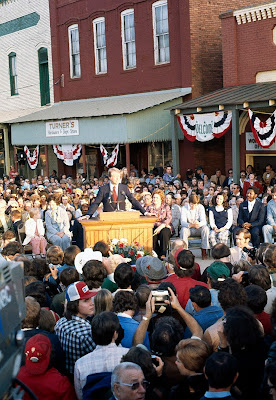Once you enter the depot, long devoid of frequent activity, a single video can be heard echoing throughout the building. It is a video that Charles Plant put together on the 1976 election. The images are old and the voices heard are those that use to fill the television screens in countless homes decades earlier. The nightly news anchors of the past; Cronkite, Harry Reasoner, and John Chancellor, can be heard. The desired effect is easily achieved, transporting visitors back to a time when this depot was packed with locals and campaign workers and primary nights would turn into local vigils and tailgate festivals, as several TVs were installed to witness the results of so many past contests, when their favorite son was trying to achieve the impossible.
. Two rocking chairs, used frequently by America’s First Mother, Lillian Carter, can still be seen. Today, a sign proudly and humorously recounts the fact that “Behind this closed door” is the reason why the depot was selected as the campaign headquarters. It was the location of the only available public bathroom in town. Today the bathroom is closed and visitors are prevented from entering this historic lavatory.
As the election of Jimmy Carter became a real possibility, both the candidate and his hometown started becoming big business. Carter’s wide smile began showing up everywhere in town and souvenir makers had a field day turning the town into a household name nationwide. Some, like the N.G. Slater campaign buttons were of high quality, while others were simply made by an endless series of small entrepreneurs looking for an easy buck. Eventually, the massive level of outside guests began to die down. After the Carter Presidency entered the history books, the town and its famous son both shared in parallel struggles to acclimate themselves to life outside the national spotlight. Plains and Carter both took it upon themselves to help preserve the best elements of the 1976 election and its aftermath for posterity. It was not an easy task for them both. But, President Carter threw himself into the task of turning key structures of his hometown into a national park. With the aid of the residents and outside support, the former president succeeded beyond his wildest hopes.
The town’s train depot was constructed in 1888 and was, for a time, the only building with a public bathroom. This was the primary reason for its selection as the hometown headquarters for the Carter Presidential campaign. It was the site of numerous hometown primary parties and was where candidate Carter would hold interviews whenever in town. As the 1970s dawned, Plains remained largely unchanged. But, following his announcement for president, the entire landscape of the community began to change. The primary night parties would begin at the depot and quickly took on a church potluck atmosphere. There were said to have been rows of flatbed trucks everywhere and tiny campers.
This commemorative T-shirt, owned by Plains resident and Peanut Brigader Ida English. This shirt and other souvenirs were proudly displayed by Jimmy Carter’s supporters to celebrate his victory in the 1976 presidential election. This style of shirt was worn by Peanut Brigaders on the night of Jimmy Carter's Presidential election. It was the idea of Maxime Reese to have these t shirts made and it wasn't until Jimmy Carter won late in the early morning that those on the platform reveled the t shirts. Miss Lillian raised her tired self from her rocking chair on the Platform to reveal her shirt and suddenly fell down. Laughing she soon recovered and the crowd went wild.
The Town in a short period of time had gone from a sleepy community of 600 people into the capital of American political life. While the nation's major cities were spending millions each year to attract new residences to their communities. The town of Plains was getting up to 10 thousand tourists a day and hadn't spend a dime. But, of-course all of that was soon to change.
The inside of the train depot museum during the 1980s. Following 1979 the crowds in Plains began to die down and once Carter lost re-election the community began to turn sleepy once again. There was till tourists, but never like the glory days. Before the National Park Service became actively involved in preserving the town, the depot served as the town’s visitor center. Today it has interactive exhibits and detailed accounts of the 1976 election. But, when this picture was taken, the citizens of Plains relied almost solely on their own personal memorabilia to fill the museum.
The Jimmy Carter National Historic site and preservation district was established by an Act of Congress in 1987. The historic site consists of the railroad depot, shown here in the early 1980s, that had fallen into disrepair, the boyhood home, that needed to be purchased, and the Carter compound. The preservation district consists of the historic district and 650 acres of agricultural lands.

The Depot Museum was designed to retain all the humble charms of its 1970's structure and to also host a grouping of anecdotes from the 1976 election. In the beginning the town could only depend on the relics they themselves still had in their homes and in shops on Main Street. But, then Carter Presidential Collectors began to make very generous donations to the site and the place became one of the most appealing parts of the historic district.





No comments:
Post a Comment